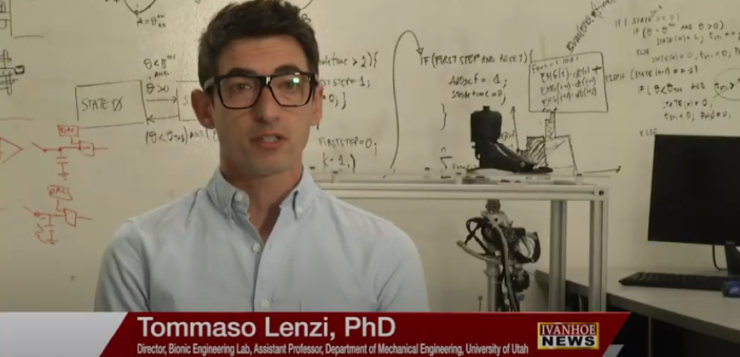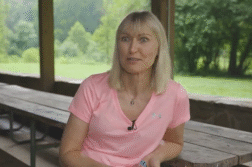Tommaso Lenzi, PhD, director of bionic engineering lab, assistant professor, core faculty in the Utah Robotics Center, department of mechanical engineering at the University of Utah, talks about their new self-powered prosthetic leg with computer processors and motorized joints for lower-limb amputees.
Did you create the world’s first truly bionic leg?
Professor Lenzi: Yes. So, it’s actually been quite a long process. We have developed a bionic leg, which is the first device that can really replicate the biomechanical function of biological legs.
We cover a lot of stories on amputees and the new technology. What makes this different?
Professor Lenzi: Compared to prostheses that are available on the market, it has monitors, sensors, batteries, and controls. What these technologies do is that they can help a person with an acute disability, for example, standing up or walking or climbing stairs. And when it does that, all of these technologies are replicating what the neuromuscular system do.
Does it read the body? Can it tell what the person wants it to do?
Professor Lenzi: Yes. It’s a combination of different things. Ambulation is actually really hard because it looks like things may be similar, but in reality, every step is different and every person is different as well. What our bionic leg does is that it has several sensors that look at the environment itself. For example, looks if there’s load on the bionic leg, if it’s moving in the space, if it’s impacting the ground. That’s one thing that the bionic leg does to understand what the user wants to do. Then, the other thing is we have sensors that can read the contractions of the muscles inside the socket on the residual limb of the user and then enables these contractions to change the amount of assistance the bionic leg provides to the user.
Ae those what you were calling smart sensors?
Professor Lenzi: Yes. We have these smart sensors. Again, for example, when you stand up with the bionic leg, you can get more or less assistance depending on how hard you contract your muscles. But at the same time, you can also read how fast you want to stand up. So, if you try and stand up faster, then you’re going to get more assistance from the leg. If you try to stand up slower, we’re going to provide less assistance to you. The idea is that we want to match what the biological leg will do during the same activity.
How does it read how tight your muscles are constricting or what the muscles are doing?
Professor Lenzi: We have some sensors that are in contact with the skin. When you contract your muscles, that generates some electrical potential, or voltage. We can pick up the voltage and understand how hard you’re contracting your muscles. Based on these contractions, we can regulate all the motors work and how much assistance the monitors are providing. That’s one kind of sensor that we have. We also have mechanical sensors. For example, there’s one sensor we call IMU that senses where the leg is in space. For example, if it’s vertical, horizontal, and it can also sense how fast you move. When you swing your leg back and forth, an IMU can tell us how fast you are swinging your leg back and forth. Finally, we have a custom force sensor so we can read if the leg is off the ground or on the ground and can read how much you’re pushing on your leg. That tells us if you are standing with both feet on the ground or if you’re only standing on the prosthesis.
Is it personalized for each patient?
Professor Lenzi: The sensors are the same. But we look at the readings of these sensors and we have models that are adapted to each user. Of course, you can imagine some users are heavier and some are lighter. So, that would affect the reading of the floor sensing in the ground reaction force on our bionic leg. There are the things that we need to adjust to first, the user, for example. For taller subjects, we need to make the leg taller as well. And of course, we change the foot to match the size of the biological foot. All of these changes we make, we’re kind of matching up to the biological anatomy.
So, something else that’s different about this leg is what it’s made of?
Professor Lenzi: Yes. There are a handful of other bionic devices around the world that have been developed. One issue they have is they’re really, really heavy because, as you can imagine, you have to add monitors. You apply the batteries and the transmission system and all these components that you’re adding to replicate the biological leg that tends to be heavy. So, we spend a huge amount of effort in minimizing the weight. And, we have achieved something that is very unique because our devices are about half the weight of any other bionic devices out there. You can still provide the same or even higher amount of torque. So, it’s very strong, but very lightweight.
Why is that so important?
Professor Lenzi: Being lightweight is very critical for an amputee. Carrying the weight of the prosthesis with you all day, it’s tiring. Sometimes when we talk with our subjects, they’ll say that even a heavier shoe will make a difference at the end of the day. So you can easily imagine that when you add a prosthesis, about 11 to 14 pounds, it’s a lot of effort and also affects their balance as they walk because they’re swinging a leg that is very heavy. What we did is develop new transmission systems and new actuators. They’re extremely lightweight and efficient. This way we have a leg that is very lightweight.
When will we see this type of leg become available to the masses?
Professor Lenzi: It’s hard to tell when this is going to become a reality for everyone. I hope it’s going to be out there in the next five to 10 years. But it really depends on what we as researchers are going to be able to do. It’s fundamental for us to keep developing new mechanical solutions and new controllers that can adapt to what the user wants to do. It’s also very important that we create and establish the science behind the use of these devices. Demonstrating that these bionic devices are better than commercially available devices is not easy because it requires us to have a pool of participants in our study, and of course, to measure and record what happens with the bionic leg, and then demonstrate that there’s a difference.
What do you think the biggest benefit is?
Professor Lenzi: I think the benefit depends on the user. For subjects that are elderly, the ability to stand up naturally, or be assisted when they stand up, is a huge benefit for them. It can make a big difference in their daily life. But for someone who’s younger and more active, the biggest difference is the kind of activities that they can do. With a conventional prosthesis, there are some things that you’re just not able to do like squatting, lunging, or stepping over obstacles. Our bionic devices enable them to do more activities in a way that is more natural. They can walk faster and farther and deal with environmental constraints. One thing that we can do with our bionic leg is climb stairs, step overstep. With a conventional prosthesis, that is not possible. We can even enable them to climb two steps at a time, which is something our younger subjects love to do.
What made Alec a good first person to try this out?
Professor Lenzi: Alec has been with us since the beginning of our project. He’s been such a great subject because he’s a very active person and a person that wants to be active. But at the same time, he is also critical about what the leg can do. It really helped us in pushing the boundaries. He is always asking us to do more. This has really been a source of inspiration for us to try new activities and develop new controllers that can help him achieve what he wants to.
Interview conducted by Ivanhoe Broadcast News.
END OF INTERVIEW
This information is intended for additional research purposes only. It is not to be used as a prescription or advice from Ivanhoe Broadcast News, Inc. or any medical professional interviewed. Ivanhoe Broadcast News, Inc. assumes no responsibility for the depth or accuracy of physician statements. Procedures or medicines apply to different people and medical factors; always consult your physician on medical matters.
If you would like more information, please contact:
Tommaso Lenzi
Sign up for a free weekly e-mail on Medical Breakthroughs called First to Know by clicking here




